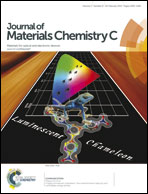Ambipolar, multi-electrochromic polypyromellitimides and polynaphthalimides containing di(tert-butyl)-substituted bis(triarylamine) units
Abstract
Four bis(triarylamine)-based polyimides were prepared from the polycondensation reactions of diamine monomers, N,N-bis(4-aminophenyl)-N′,N′-bis(4-tert-butylphenyl)-1,4-phenylenediamine (1) and 4,4′-diamino-4′′-(3,6-di-tert-butylcarbazol-9-yl)triphenylamine (1′), with pyromellitic dianhydride (PMDA) and 1,4,5,8-naphthalenetetracarboxylic dianhydride (NTDA), respectively. These polyimides showed high glass transition temperatures and high thermal stability. Cyclic voltammetry studies revealed that these polyimides were ambipolar; they showed well-defined and reversible redox couples during both p- and n-doping processes, together with multi-electrochromic behaviors and high contrast ratios in the visible and near-infrared regions. An all-plastic flexible electrochromic device (ECD) based on polypyromellitimide 3a was constructed and characterized. The device shows a maximum optical contrast (ΔT%) of 85% at 940 nm for green coloring and of 91% at 760 nm for deep blue coloring.


 Please wait while we load your content...
Please wait while we load your content...